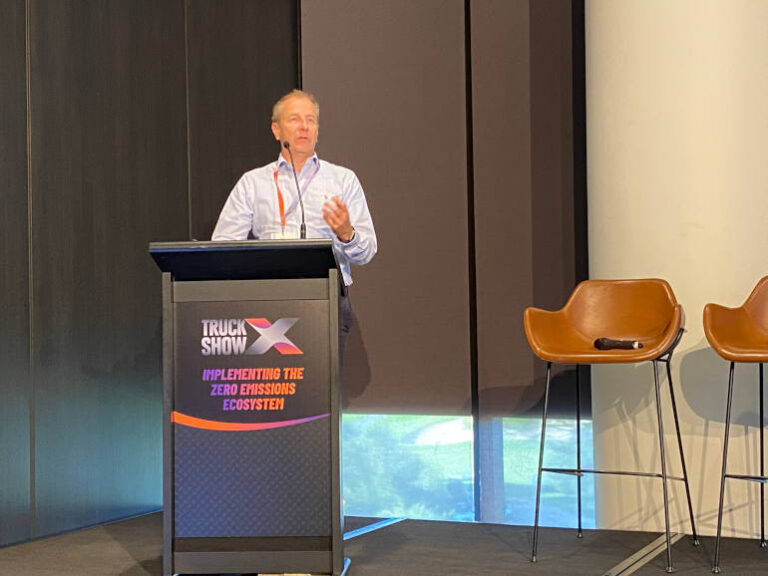In one of the few case study presentations at TruckShowX, Paul Kahlert, CEO of All Purpose Transport (APT), provided an insightful overview of the company’s transformative journey towards electric vehicles (EVs).
The beginning of a daunting journey
Paul Kahlert began his speech by setting the stage for the significant transition APT has undergone. Established in Queensland for 49 years, APT operates a fleet of 300 vehicles, including small vans, refrigerated vehicles, and removal trucks. With a contractor owner-driver model, they execute around 3,000 last-mile deliveries daily for major clients like IKEA.
The catalyst for their EV journey was a bold challenge from IKEA, which demanded APT to go fully electric within six years. For a company a fleet of diesel powered vehicles, this was a formidable task. Kahlert reflected on the initial hurdles, stating, “When IKEA came along… you just have to do some out-of-the-box type thinking.”
Overcoming initial challenges
In 2018, when APT embarked on this journey, the market lacked readily available electric trucks. Kahlert highlighted, “You couldn’t go to a dealer on electric truck, there was no such thing… you had vehicles being converted.”
The financial aspect was equally challenging, with costs for a four-tonne vehicle reaching $180,000 to $190,000. Despite these barriers, the necessity to meet IKEA’s requirements and secure the jobs of 40 families pushed APT to innovate. One of the pivotal strategies was changing the narrative from a purely environmental angle to a health-centric one.
“We flipped it on its head and looked at it from a different angle… a four-ton truck produces around 12 tons of CO2 every year… but it creates a lot of health issues around asthma, allergies, and respiratory illness,” Kahlert explained. This reframing helped garner internal support and align their goals with broader community health benefits.
The electric transition
By 2019, APT launched its first electric vehicle program. The launch was marked by significant media attention and public interest. However, practical challenges soon emerged, especially regarding vehicle range and infrastructure. Kahlert noted, “It was very, very hard to take that truck and to drive anywhere out in Brisbane… once you got it out there, a tilt tray was going to bring it back because if you’ve got the range wrong and you set up the routing wrong, the truck ran out of power..”
The charging infrastructure posed additional problems. Existing facilities were designed for cars, not trucks, leading to logistical nightmares. Nonetheless, the company adapted, utilising available spaces creatively to establish 16 charging points at their warehouse
Scaling up and strategic learnings
A critical learning phase occurred when APT scaled their fleet from five electric trucks. “The immediate reaction is you want to charge the trucks quickly… but those trucks are actually going out start the morning at six o’clock, and then at backwater debt by four o’clock,” Kahlert shared, emphasising that slower, overnight AC charging proved sufficient and cost-effective.
To facilitate this transition, APT initially bore the capital expenditure, relieving their owner-drivers from the financial burden. They later partnered with a financing firm (Car-bon), creating a model where drivers paid a fixed weekly amount covering all costs. This model proved effective, reducing daily energy expenses to about $14-$16, significantly lower than diesel costs.
Achieving milestones and looking ahead
Reflecting on the progress made, Kahlert proudly announced, “From 2019 to 2024… we’ve now got 30 tonnes of CO2 out of the air monthly.” The fleet now includes 15 electric vehicles, with plans to expand further. The goal-oriented approach, driven by IKEA’s targets, provided a clear roadmap and motivation.
Kahlert also highlighted the evolving technology, with new EV models being more reliable and familiar to drivers. “The Ford Transit is what most of these guys are driving as a diesel version right now… it’s just like they’re getting a new model car,” he remarked.
APT’s journey has not only been about internal transformation but also about setting a precedent in the industry. Their commitment to sustainability has become a competitive advantage, attracting clients with robust ESG reporting requirements. “We won the Cotton On work… on the back of the fact that we could tell them… we’re saving CO2,” Kahlert noted.
Concluding thoughts
APT’s journey into electric vehicles illustrates the intersection of innovation, strategic thinking, and community responsibility. As Kahlert concluded, the shift towards EVs is not just about reducing emissions but about being a responsible employer and community member. “Our staff can now see that we’re serious… we’ve got 15 of these vehicles operating out there,” he affirmed.
For fleet operators and industry stakeholders, APT’s story is a testament to the power of resilience and forward-thinking in navigating the challenges and reaping the rewards of sustainable transformation.






